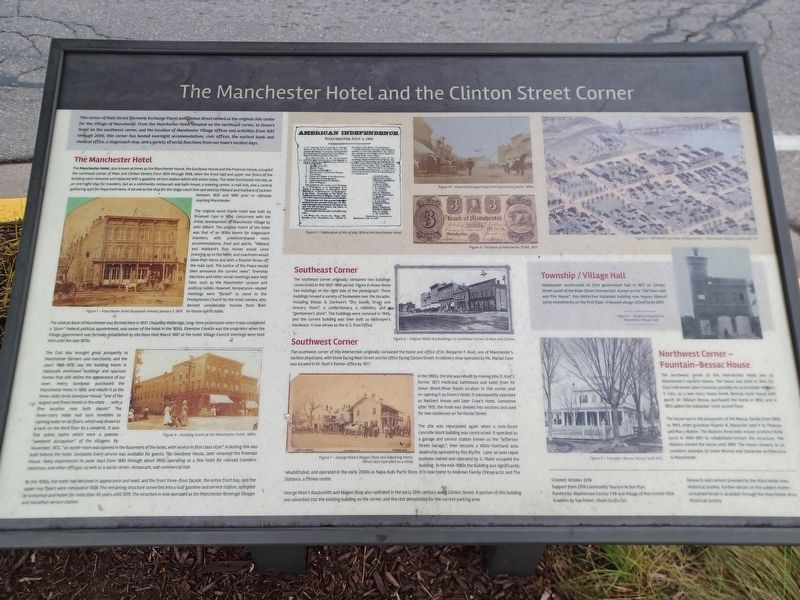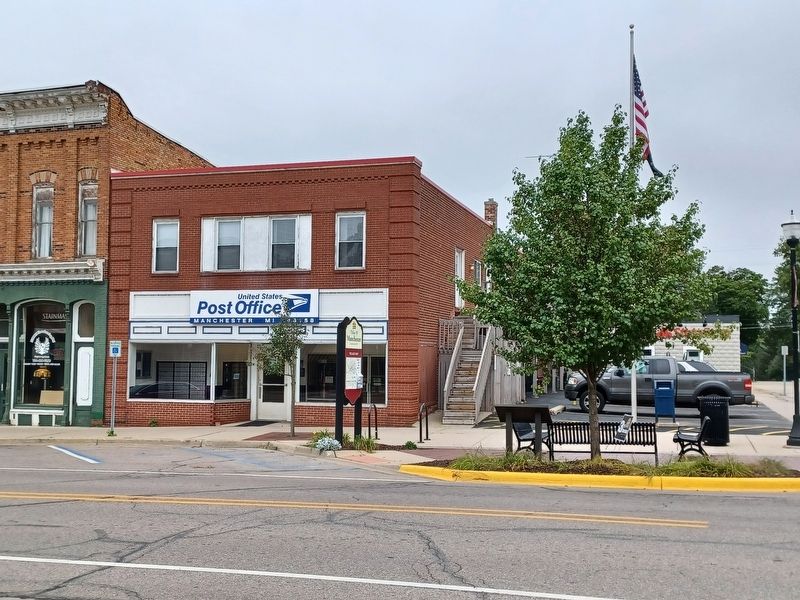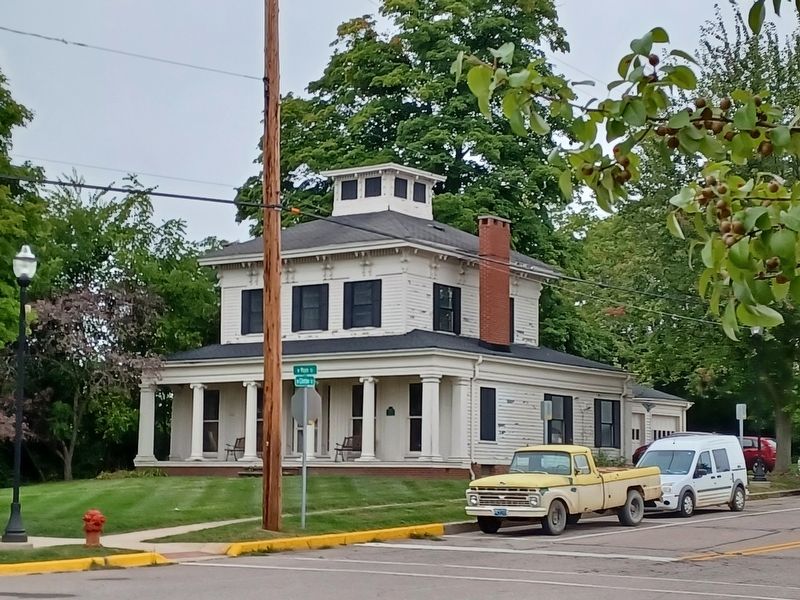Manchester in Washtenaw County, Michigan — The American Midwest (Great Lakes)
The Manchester Hotel and the Clinton Street Corner
Inscription.
This corner of Main Street (formerly Exchange Place) and Clinton Street served as the original civic center for the Village of Manchester. From the Manchester Hotel situated on the northeast corner, to Green's Hotel on the southwest corner, and the location of Manchester Village offices and activities from 1837 through 2000, this corner has hosted overnight accommodations, civic offices, the earliest bank and medical office, a stagecoach stop, and a variety of social functions from our town's earliest days.
The Manchester Hotel
The Manchester Hotel, also known at times as the Manchester House, the Goodyear House and the Freeman House, occupied the northeast corner of Main and Clinton Streets from 1834 through 1938, when the front half and upper rear floors of the building were removed and replaced with a gasoline service station which still exists today. The hotel functioned not only as an overnight stay for travelers, but as a community restaurant and bath house, a meeting center, a mail hub, and a central gathering spot for important news. It served as the stop for the stage coach line operated by Hibbard and Hubbard of Jackson between 1835 and 1860 prior to railroads reaching Manchester.
The original wood frame hotel was built by Emanuel Case in 1834, concurrent with the initial development of Manchester Village by John Gilbert. The original intent of the hotel was that of an 1830s tavern for stagecoach travelers, with primitive/shared room accommodations, food and spirits. "Hibbard and Hubbard's four horses would come prancing up to the hotel, and coachmen would blow their horns and with a flourish throw off the mail sack. The Justice of the Peace would then announce the current news." Township elections and other social meetings were held here, such as the Manchester Lyceum and political rallies. However, temperance-related meetings were "forced" to move to the Presbyterian Church by the hotel owners, who derived considerable income from their in-house spirits sales.
Figure 1 — Manchester Hotel (Goodyear House), January 3, 1878
The wildcat Bank of Manchester was formed here in 1837. Chauncey Walbridge, long-time postmaster when it was considered a "plum" Federal appointment, was owner of the hotel in the 1850s. Ebenezer Conklin was the proprietor when the Village government was formally established by elections held March 1867 at the hotel. Village Council meetings were held here until the late 1870s.
The Civil War brought great prosperity to Manchester farmers and merchants, and the years 1866-1875 saw the building boom in Italianate downtown buildings and spacious homes that still define the appearance of our town. Henry Goodyear purchased the Manchester
Hotel in 1869, and rebuilt it as the three-story brick Goodyear House, "one of the largest and finest hotels in the state...with a fine location near both depots". The three-story hotel had such novelties as running water on all floors, which was drawn to a tank on the third floor by a windmill. It also had public baths which were a popular "weekend occupation" of the villagers. By November, 1872, "an oyster room was opened in the basement of the hotel, with service in first class style". A skating rink was built behind the hotel. Complete livery service was available for guests. The Goodyear House, later named the Freeman House, likely experienced its peak days from 1869 through about 1900, operating as a fine hotel for railroad travelers, salesman, and other officials, as well as a social center, restaurant, and commercial hub.
Figure 4 — Bustling Scene at the Manchester Hotel, 1890s
By the 1930s, the hotel had declined in appearance and need, and the front three-floor façade, the entire front bay, and the upper rear floors were removed in 1938. The remaining structure converted into a Gulf gasoline and service station, operated by Grossman and Huber for more than 40 years until 1979. The structure is now operated as the Manchester Beverage Shoppe and Marathon service station.
Southeast Corner
The southeast corner originally
contained two buildings constructed in the 1837-1850 period. Figure 6 shows these two buildings on the right side of the photograph. These buildings housed a variety of businesses over the decades, including Bessac & Clarkson's "Dry Goods, Drugs and Grocery Store", a confectionary, a millinery, and a "gentlemen's store". The buildings were removed in 1940, and the current building was then built as Widmayer's Hardware. It now serves at the U. S. Post Office.
Figure 6 — Original 1840s Era Buildings on Southeast Corner of Main and Clinton.
Southwest Corner
The southwest corner of this intersection originally contained the home and office of Dr. Benjamin F. Root, one of Manchester's earliest physicians, with home facing Main Street and his office facing Clinton Street. A millinery shop operated by Ms. Marian Case was located in Dr. Root's former office by 1871.
In the 1890s, the site was rebuilt by moving John D. Kief's former 1873 medicinal bathhouse and hotel from its Union Street/River Raisin location to this corner, and re-opening it as Green's Hotel. It subsequently operated as Reichert House and later Craw's Hotel. Sometime after 1913, the hotel was divided into sections and used for two residences on Territorial Street.
The site was repurposed again when a rock-faced concrete block building was constructed. It operated as a garage and service station known as the "Jefferson Street Garage," then became a Willis-Overland auto dealership operated by Roy Blythe. Later an auto repair business owned and operated by G. Mann occupied the building. In the mid-1980s the building was significantly rehabilitated, and operated in the early 2000s as Napa Auto Parts Store. It is now home to Andrews Family Chiropractic and The Distance, a fitness center.
George Nisle's Blacksmith and Wagon Shop also operated in the early 20th century along Clinton Street. A portion of this building was absorbed into the existing building on the corner, and the rest demolished for the current parking area.
Figure 7 — George Nisle's Wagon Shop and Adjoining Home, Which also Operated as a Hotel
Northwest Corner - Fountain-Bessac House
The northwest corner of this intersection holds one of Manchester's earliest homes. The house was built in 1842 for flour mill owner Jabez Fountain, possibly by local builder William S. Carr, as a one-story house Greek Revival-style house with porch. Dr. William Bessac purchased the home in 1850, and in 1853 added the Italianate-style second floor.
The house was in the possession of the Bessac family from 1850 to 1943, when grandson Raynor B. Haeussler sold it to Thomas and Mary Walton. The Waltons hired well-known architect Emil Lorch in 1949-1951 to rehabilitate/restore the structure. The Waltons owned the house until 1989. The house remains as an example of Greek Revival and Italianate architecture in Manchester.
Figure 9 — Fountain-Bessac House, Built 1842
Township / Village Hall
Manchester constructed its first government hall in 1877 on Clinton Street south of the Main Street intersection. Known as the "Old Town Hall and Fire House", this distinctive Italianate building now houses Edward Jones Investments on the first floor. It housed village offices until 2001.
Figure 8 — Original Manchester Township/Village Hall
Created: November 2016
Support from 2016 Community Tourism Action Plan
Funded by: Washtenaw County CVB and Village of Manchester DDA
Graphics by Sue Maher, Moxie Grafix LLC
Research and content provided by the Manchester Area Historical Society. Further details on the subject matter contained herein is available through the Manchester Area Historical Society.
Erected 2017.
Topics. This historical marker is listed in this topic list: Notable Buildings. A significant historical date for this entry is January 3, 1878.
Location. 42° 8.963′ N, 84° 2.395′ W. Marker is in Manchester, Michigan, in Washtenaw County. Marker is at the intersection of East Main Street and Clinton Street, on the left when traveling south on East Main Street. Touch for map. Marker is at or near this postal address: 103 East Main Street, Manchester MI 48158, United States of America. Touch for directions.
Other nearby markers. At least 8 other markers are within walking distance of this marker. Fountain-Bessac House (within shouting distance of this marker); History of the Manchester Mill (about 400 feet away, measured in a direct line); The Founding of Manchester (about 400 feet away); Exchange Place (about 400 feet away); Manchester's Village Green (about 500 feet away); Manchester Township Library / James A. Lynch House (about 500 feet away); Veteran's Memorial (about 600 feet away); Village of Manchester (about 700 feet away). Touch for a list and map of all markers in Manchester.
Credits. This page was last revised on June 21, 2023. It was originally submitted on September 14, 2022, by Joel Seewald of Madison Heights, Michigan. This page has been viewed 290 times since then and 155 times this year. Photos: 1, 2, 3. submitted on September 14, 2022, by Joel Seewald of Madison Heights, Michigan.


